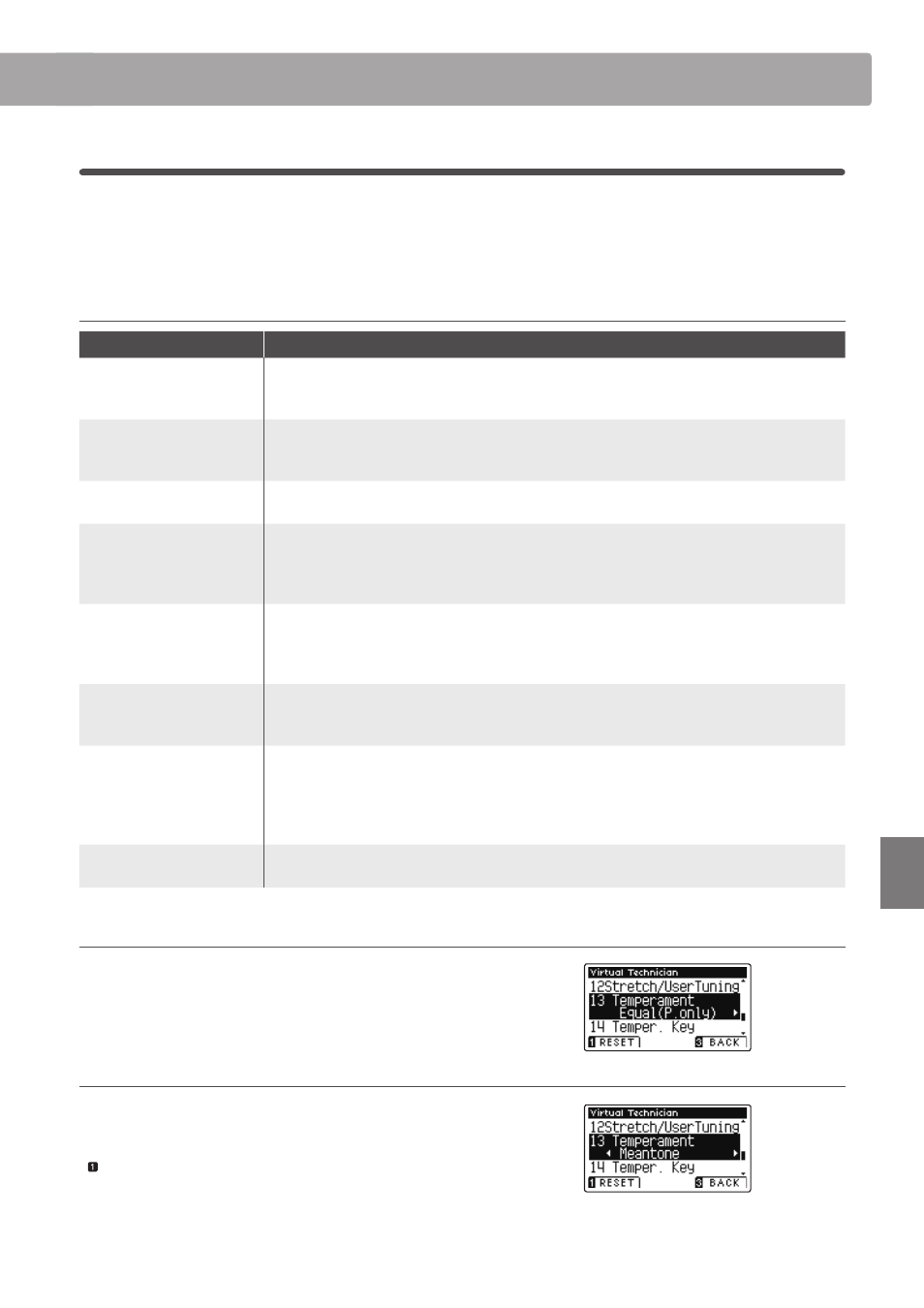Temperament, Set tings, Temperament types – Kawai ATX2/ATX2-f User Manual
Page 85: Selecting the temperament setting, Changing the temperament type

85
Set
tings
13
. Temperament
The Temperament setting allows the tuning system used by the AnyTimeX2 piano to be changed from the modern
‘Equal Temperament’ standard to one of the various temperaments popularised during the Renaissance and
Baroque periods. It is also possible to create customised temperaments using the User Temperaments function.
* This Virtual Technician setting will aff ect all sounds.
Temperament types
Temperament type
Description
Equal Temperament (piano)
(Equal P.only)
This is the default temperament. When a piano sound is selected, the tuning will be stretched like an
acoustic piano (equal temperament).
* If any other type of sound is selected, the tuning will be set to equal temperament (fl at).
Pure Temperament
(Pure Major
/
Pure Minor)
This temperament, which eliminates dissonances for thirds and fi fths, is still popular in choral music
because of its perfect harmony. Any key modulation will result in dissonances.
* The key of the temperament, and major/minor setting must be correctly matched.
Pythagorean Temperament
(Pythagorean)
This temperament, which uses mathematical ratios to eliminate dissonance for fi fths, is very limited for
use with chords, but produces very characteristic melodic lines.
Meantone Temperament
(Meantone)
This temperament, which uses a mean between a major and minor whole tone to eliminate dissonance
for thirds, was devised to eliminate the lack of consonances experienced with certain fi fths for the
Mersenne pure temperament.
It produces chords that are more beautiful than those played with equal temperament.
Werckmeister III Temperament
(Werkmeister)
Kirnberger III Temperament
(Kirnberger)
These two temperaments are placed in between Meantone and Pythagorean. For music with few
accidentals, this temperament produces the beautiful chords of the mean tone, but as accidentals
increase, the temperament produces the characteristic melodies of the Pythagorean temperament.
It is used primarily for classical music written in the Baroque era to revive the original characteristics.
Equal Temperament (fl at)
(Equal Flat)
This is an ‘unstretched’ equal temperament that divides the scale into twelve equal semi-tones. It produces
the same chordal intervals in all twelve keys, and has the advantage of limitless modulation of the key.
However the tonality of each key becomes less characteristic and no chord is in pure consonance.
Equal Temperament
(Equal Stretch)
This is the most popular piano temperament. The hearing ability of a human is uneven and is not as
accurate with high frequency and low frequency as it is with the middle range. This temperament’s
tuning is stretched to compensate for this so the sound will be heard naturally to the ears. This
‘stretched’ equal temperament is a practical variation of the ‘unstretched’ equal temperament which
was invented on a mathematical basis.
User Temperament
(User)
A custom, user temperament, created by raising or lowering the pitch for each semi-tone.
1. Selecting the Temperament setting
After entering the Virtual Technician menu (page 70):
Press the
or buttons to select the Temperament setting.
2. Changing the Temperament type
Press the
or buttons to cycle through the diff erent
Temperament types.
* To reset the Temperament setting to the default type, press the
FUNCTION button (RESET).
* Any changes made to the Temperament setting will remain until the
power is turned off .
